Risk Management in Engineering: Analysis of Failures and Prevention
VerifiedAdded on 2021/05/30
|14
|1810
|77
Report
AI Summary
This report provides an in-depth analysis of risk management within the field of engineering, emphasizing the critical need for mitigating or eliminating potential risks in projects to avoid failures. It highlights the engineer's responsibility in ensuring work aligns with its intended purpose and performance standards. The report examines several engineering failures, including the Granville train accident, the Childers backpackers hostel fire, and the Bull Bridge failure, detailing the reasons behind these incidents. It then analyzes each case, identifying methods of avoidance, engineering assessments, and lessons learned to prevent similar occurrences. The report emphasizes the importance of qualified personnel, design validation, material verification, disaster planning, quality checks, and regular inspections. By studying these failures, the report aims to provide insights into strategies for enhancing safety, reliability, and overall project success in engineering endeavors. The analysis covers material selection, structural integrity, and the role of human factors in these failures. The report concludes by emphasizing the importance of learning from past mistakes and implementing robust risk management practices to improve future engineering outcomes.

RISK MANAGEMENT IN
ENGINEERING
ENGINEERING
Paraphrase This Document
Need a fresh take? Get an instant paraphrase of this document with our AI Paraphraser
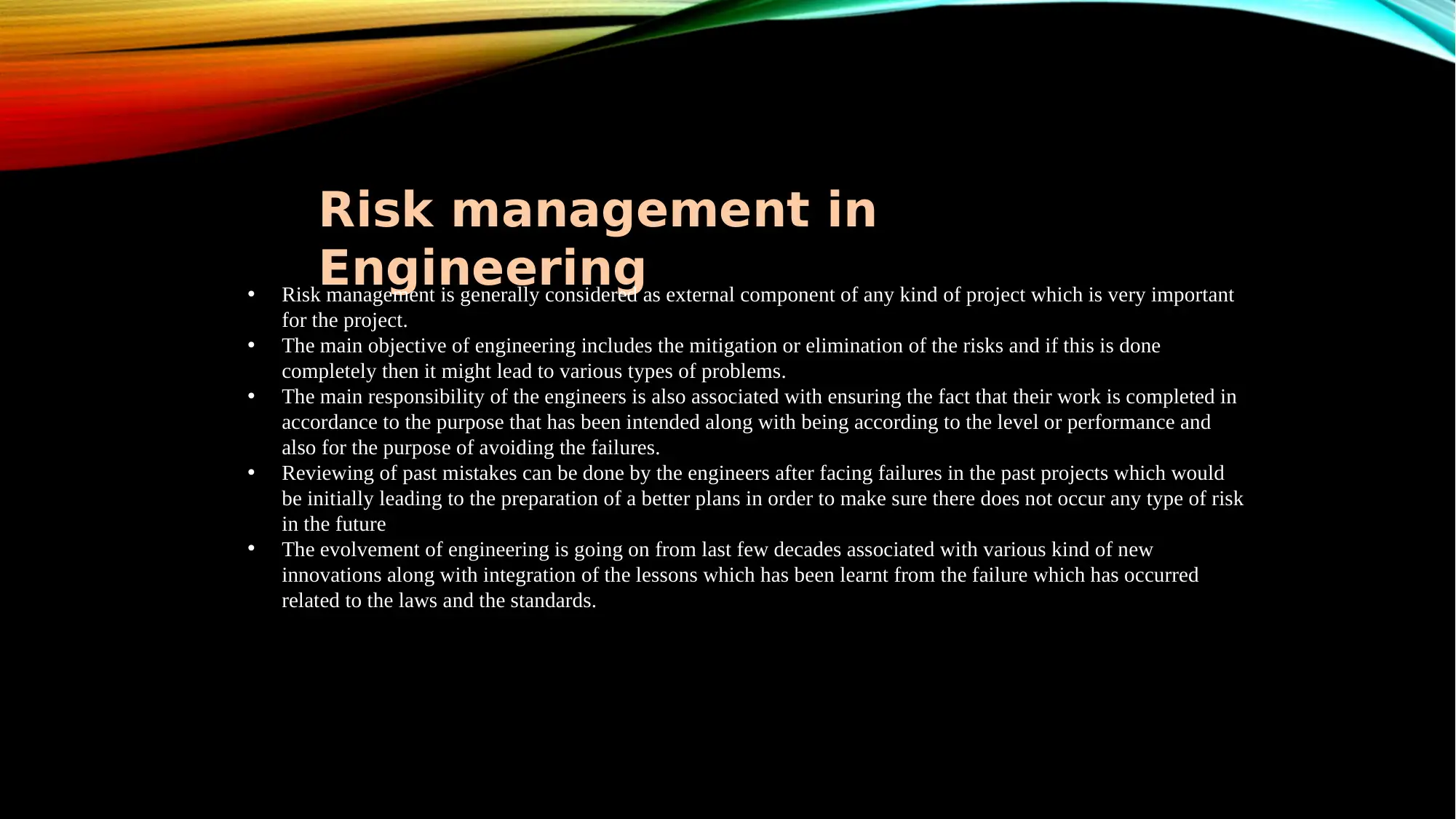
Risk management in
Engineering• Risk management is generally considered as external component of any kind of project which is very important
for the project.
• The main objective of engineering includes the mitigation or elimination of the risks and if this is done
completely then it might lead to various types of problems.
• The main responsibility of the engineers is also associated with ensuring the fact that their work is completed in
accordance to the purpose that has been intended along with being according to the level or performance and
also for the purpose of avoiding the failures.
• Reviewing of past mistakes can be done by the engineers after facing failures in the past projects which would
be initially leading to the preparation of a better plans in order to make sure there does not occur any type of risk
in the future
• The evolvement of engineering is going on from last few decades associated with various kind of new
innovations along with integration of the lessons which has been learnt from the failure which has occurred
related to the laws and the standards.
Engineering• Risk management is generally considered as external component of any kind of project which is very important
for the project.
• The main objective of engineering includes the mitigation or elimination of the risks and if this is done
completely then it might lead to various types of problems.
• The main responsibility of the engineers is also associated with ensuring the fact that their work is completed in
accordance to the purpose that has been intended along with being according to the level or performance and
also for the purpose of avoiding the failures.
• Reviewing of past mistakes can be done by the engineers after facing failures in the past projects which would
be initially leading to the preparation of a better plans in order to make sure there does not occur any type of risk
in the future
• The evolvement of engineering is going on from last few decades associated with various kind of new
innovations along with integration of the lessons which has been learnt from the failure which has occurred
related to the laws and the standards.
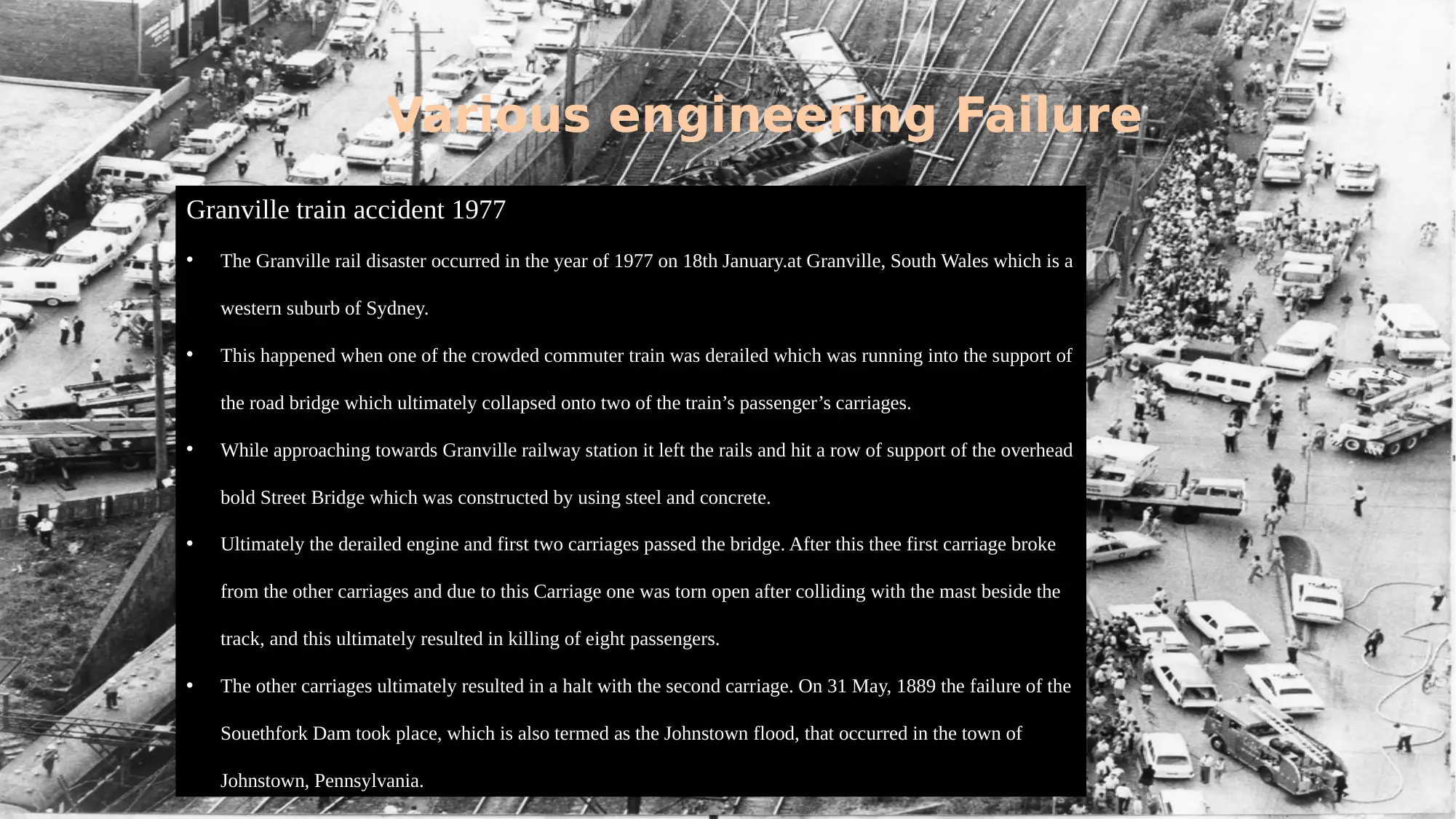
Various engineering Failure
Case 1: LARGE AND LOCALISED
Granville train accident 1977
• The Granville rail disaster occurred in the year of 1977 on 18th January.at Granville, South Wales which is a
western suburb of Sydney.
• This happened when one of the crowded commuter train was derailed which was running into the support of
the road bridge which ultimately collapsed onto two of the train’s passenger’s carriages.
• While approaching towards Granville railway station it left the rails and hit a row of support of the overhead
bold Street Bridge which was constructed by using steel and concrete.
• Ultimately the derailed engine and first two carriages passed the bridge. After this thee first carriage broke
from the other carriages and due to this Carriage one was torn open after colliding with the mast beside the
track, and this ultimately resulted in killing of eight passengers.
• The other carriages ultimately resulted in a halt with the second carriage. On 31 May, 1889 the failure of the
Souethfork Dam took place, which is also termed as the Johnstown flood, that occurred in the town of
Johnstown, Pennsylvania.
Case 1: LARGE AND LOCALISED
Granville train accident 1977
• The Granville rail disaster occurred in the year of 1977 on 18th January.at Granville, South Wales which is a
western suburb of Sydney.
• This happened when one of the crowded commuter train was derailed which was running into the support of
the road bridge which ultimately collapsed onto two of the train’s passenger’s carriages.
• While approaching towards Granville railway station it left the rails and hit a row of support of the overhead
bold Street Bridge which was constructed by using steel and concrete.
• Ultimately the derailed engine and first two carriages passed the bridge. After this thee first carriage broke
from the other carriages and due to this Carriage one was torn open after colliding with the mast beside the
track, and this ultimately resulted in killing of eight passengers.
• The other carriages ultimately resulted in a halt with the second carriage. On 31 May, 1889 the failure of the
Souethfork Dam took place, which is also termed as the Johnstown flood, that occurred in the town of
Johnstown, Pennsylvania.
⊘ This is a preview!⊘
Do you want full access?
Subscribe today to unlock all pages.

Trusted by 1+ million students worldwide
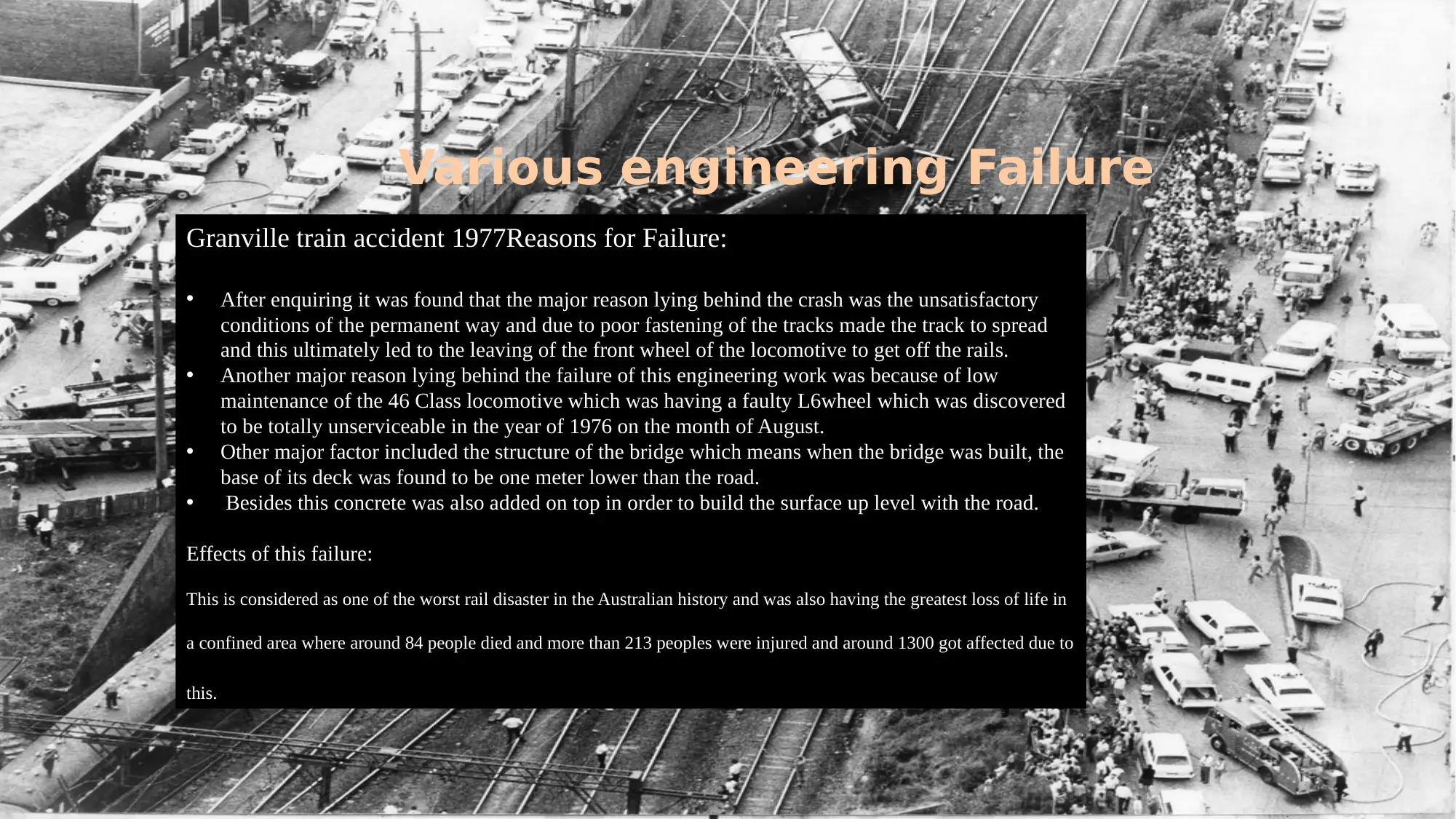
Various engineering Failure
Case 1: LARGE AND LOCALISEDGranville train accident 1977Reasons for Failure:
• After enquiring it was found that the major reason lying behind the crash was the unsatisfactory
conditions of the permanent way and due to poor fastening of the tracks made the track to spread
and this ultimately led to the leaving of the front wheel of the locomotive to get off the rails.
• Another major reason lying behind the failure of this engineering work was because of low
maintenance of the 46 Class locomotive which was having a faulty L6wheel which was discovered
to be totally unserviceable in the year of 1976 on the month of August.
• Other major factor included the structure of the bridge which means when the bridge was built, the
base of its deck was found to be one meter lower than the road.
• Besides this concrete was also added on top in order to build the surface up level with the road.
Effects of this failure:
This is considered as one of the worst rail disaster in the Australian history and was also having the greatest loss of life in
a confined area where around 84 people died and more than 213 peoples were injured and around 1300 got affected due to
this.
Case 1: LARGE AND LOCALISEDGranville train accident 1977Reasons for Failure:
• After enquiring it was found that the major reason lying behind the crash was the unsatisfactory
conditions of the permanent way and due to poor fastening of the tracks made the track to spread
and this ultimately led to the leaving of the front wheel of the locomotive to get off the rails.
• Another major reason lying behind the failure of this engineering work was because of low
maintenance of the 46 Class locomotive which was having a faulty L6wheel which was discovered
to be totally unserviceable in the year of 1976 on the month of August.
• Other major factor included the structure of the bridge which means when the bridge was built, the
base of its deck was found to be one meter lower than the road.
• Besides this concrete was also added on top in order to build the surface up level with the road.
Effects of this failure:
This is considered as one of the worst rail disaster in the Australian history and was also having the greatest loss of life in
a confined area where around 84 people died and more than 213 peoples were injured and around 1300 got affected due to
this.
Paraphrase This Document
Need a fresh take? Get an instant paraphrase of this document with our AI Paraphraser
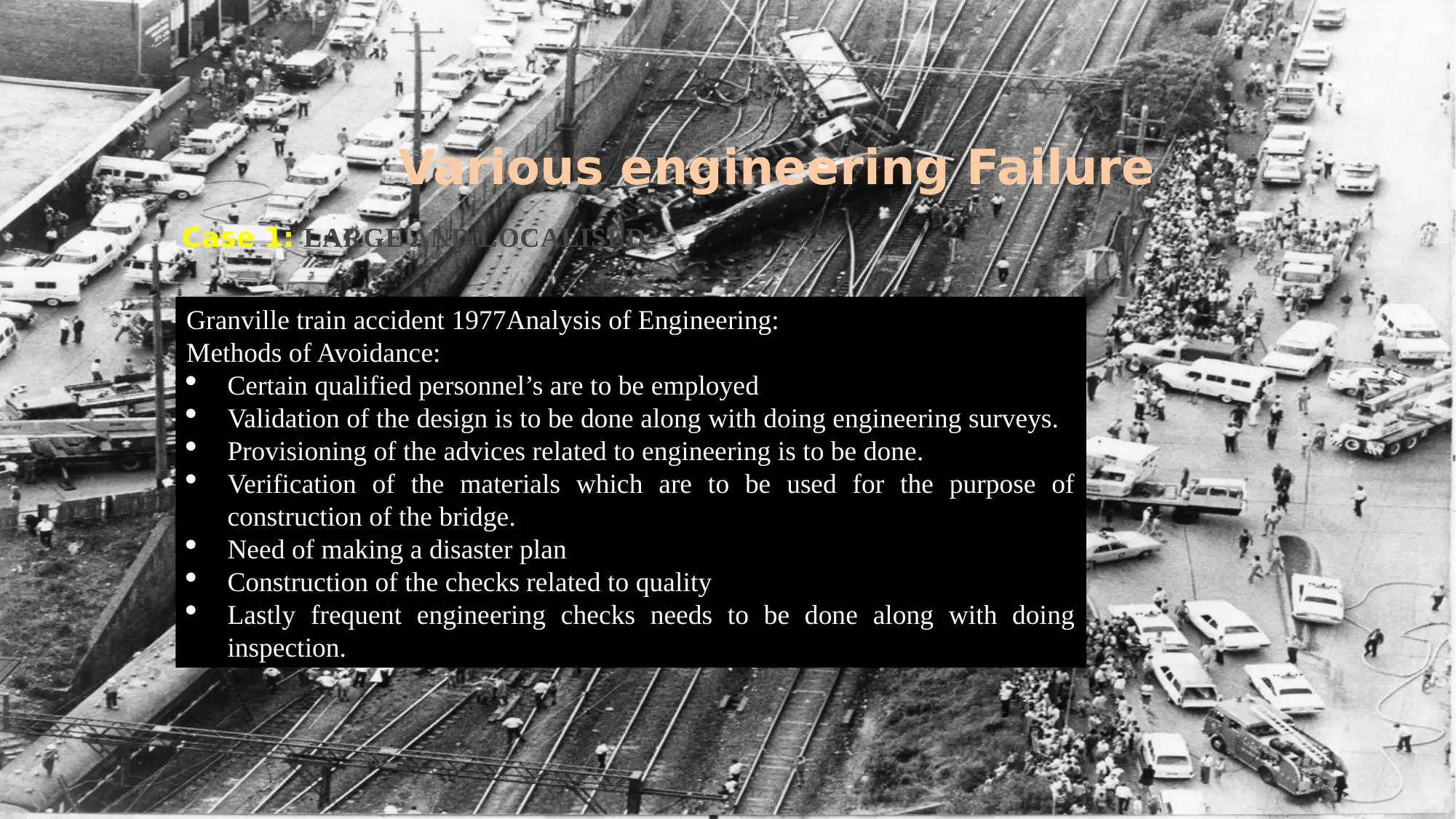
Various engineering Failure
Case 1: LARGE AND LOCALISED
Granville train accident 1977Analysis of Engineering:
Methods of Avoidance:
Certain qualified personnel’s are to be employed
Validation of the design is to be done along with doing engineering surveys.
Provisioning of the advices related to engineering is to be done.
Verification of the materials which are to be used for the purpose of
construction of the bridge.
Need of making a disaster plan
Construction of the checks related to quality
Lastly frequent engineering checks needs to be done along with doing
inspection.
Case 1: LARGE AND LOCALISED
Granville train accident 1977Analysis of Engineering:
Methods of Avoidance:
Certain qualified personnel’s are to be employed
Validation of the design is to be done along with doing engineering surveys.
Provisioning of the advices related to engineering is to be done.
Verification of the materials which are to be used for the purpose of
construction of the bridge.
Need of making a disaster plan
Construction of the checks related to quality
Lastly frequent engineering checks needs to be done along with doing
inspection.
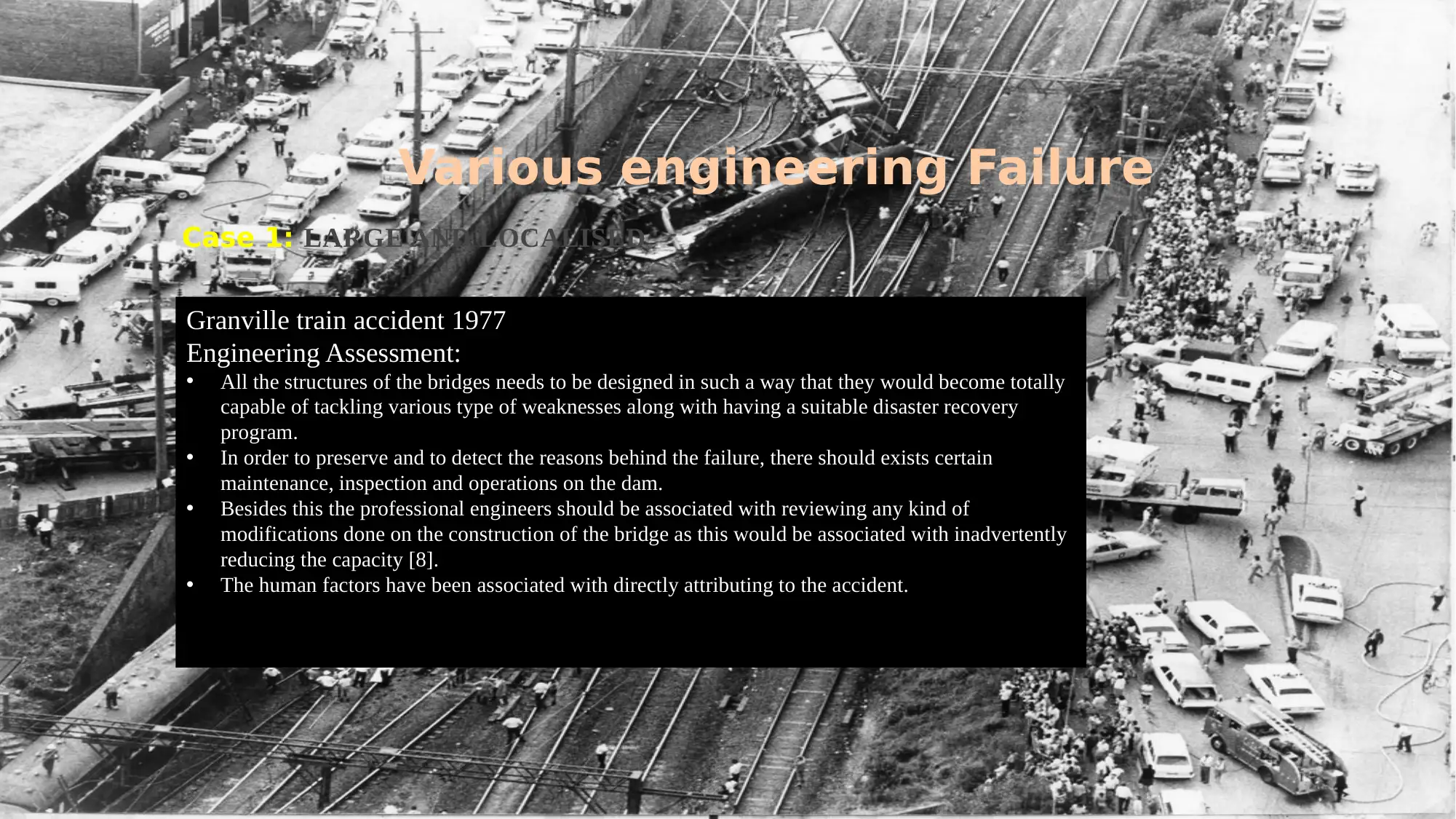
Various engineering Failure
Case 1: LARGE AND LOCALISED
Granville train accident 1977
Engineering Assessment:
• All the structures of the bridges needs to be designed in such a way that they would become totally
capable of tackling various type of weaknesses along with having a suitable disaster recovery
program.
• In order to preserve and to detect the reasons behind the failure, there should exists certain
maintenance, inspection and operations on the dam.
• Besides this the professional engineers should be associated with reviewing any kind of
modifications done on the construction of the bridge as this would be associated with inadvertently
reducing the capacity [8].
• The human factors have been associated with directly attributing to the accident.
Case 1: LARGE AND LOCALISED
Granville train accident 1977
Engineering Assessment:
• All the structures of the bridges needs to be designed in such a way that they would become totally
capable of tackling various type of weaknesses along with having a suitable disaster recovery
program.
• In order to preserve and to detect the reasons behind the failure, there should exists certain
maintenance, inspection and operations on the dam.
• Besides this the professional engineers should be associated with reviewing any kind of
modifications done on the construction of the bridge as this would be associated with inadvertently
reducing the capacity [8].
• The human factors have been associated with directly attributing to the accident.
⊘ This is a preview!⊘
Do you want full access?
Subscribe today to unlock all pages.

Trusted by 1+ million students worldwide
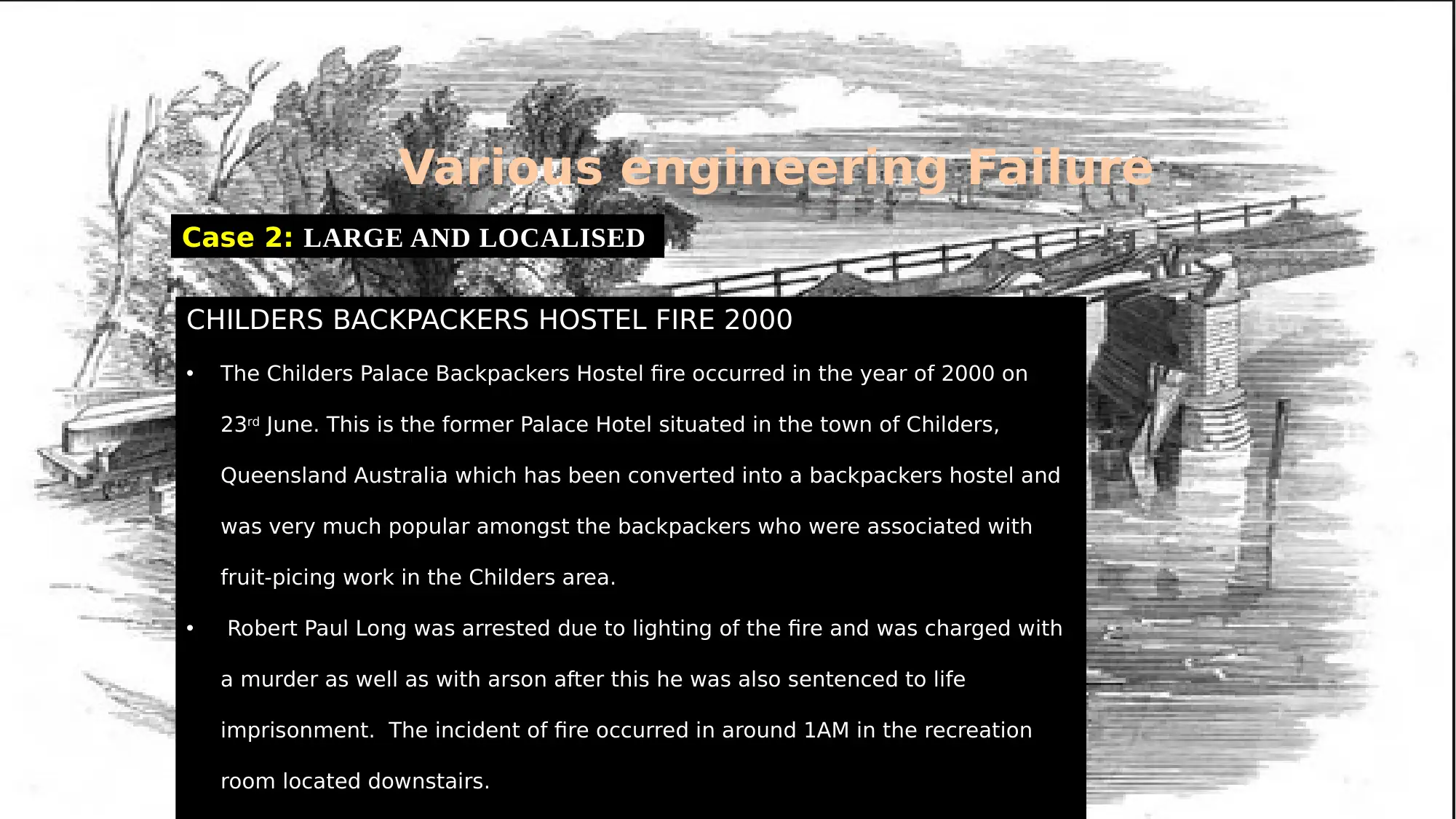
Various engineering Failure
Case 2: MEDIUM AND LOCALISED
CHILDERS BACKPACKERS HOSTEL FIRE 2000
• The Childers Palace Backpackers Hostel fire occurred in the year of 2000 on
23rd June. This is the former Palace Hotel situated in the town of Childers,
Queensland Australia which has been converted into a backpackers hostel and
was very much popular amongst the backpackers who were associated with
fruit-picing work in the Childers area.
• Robert Paul Long was arrested due to lighting of the fire and was charged with
a murder as well as with arson after this he was also sentenced to life
imprisonment. The incident of fire occurred in around 1AM in the recreation
room located downstairs.
Case 2: LARGE AND LOCALISED
Case 2: MEDIUM AND LOCALISED
CHILDERS BACKPACKERS HOSTEL FIRE 2000
• The Childers Palace Backpackers Hostel fire occurred in the year of 2000 on
23rd June. This is the former Palace Hotel situated in the town of Childers,
Queensland Australia which has been converted into a backpackers hostel and
was very much popular amongst the backpackers who were associated with
fruit-picing work in the Childers area.
• Robert Paul Long was arrested due to lighting of the fire and was charged with
a murder as well as with arson after this he was also sentenced to life
imprisonment. The incident of fire occurred in around 1AM in the recreation
room located downstairs.
Case 2: LARGE AND LOCALISED
Paraphrase This Document
Need a fresh take? Get an instant paraphrase of this document with our AI Paraphraser
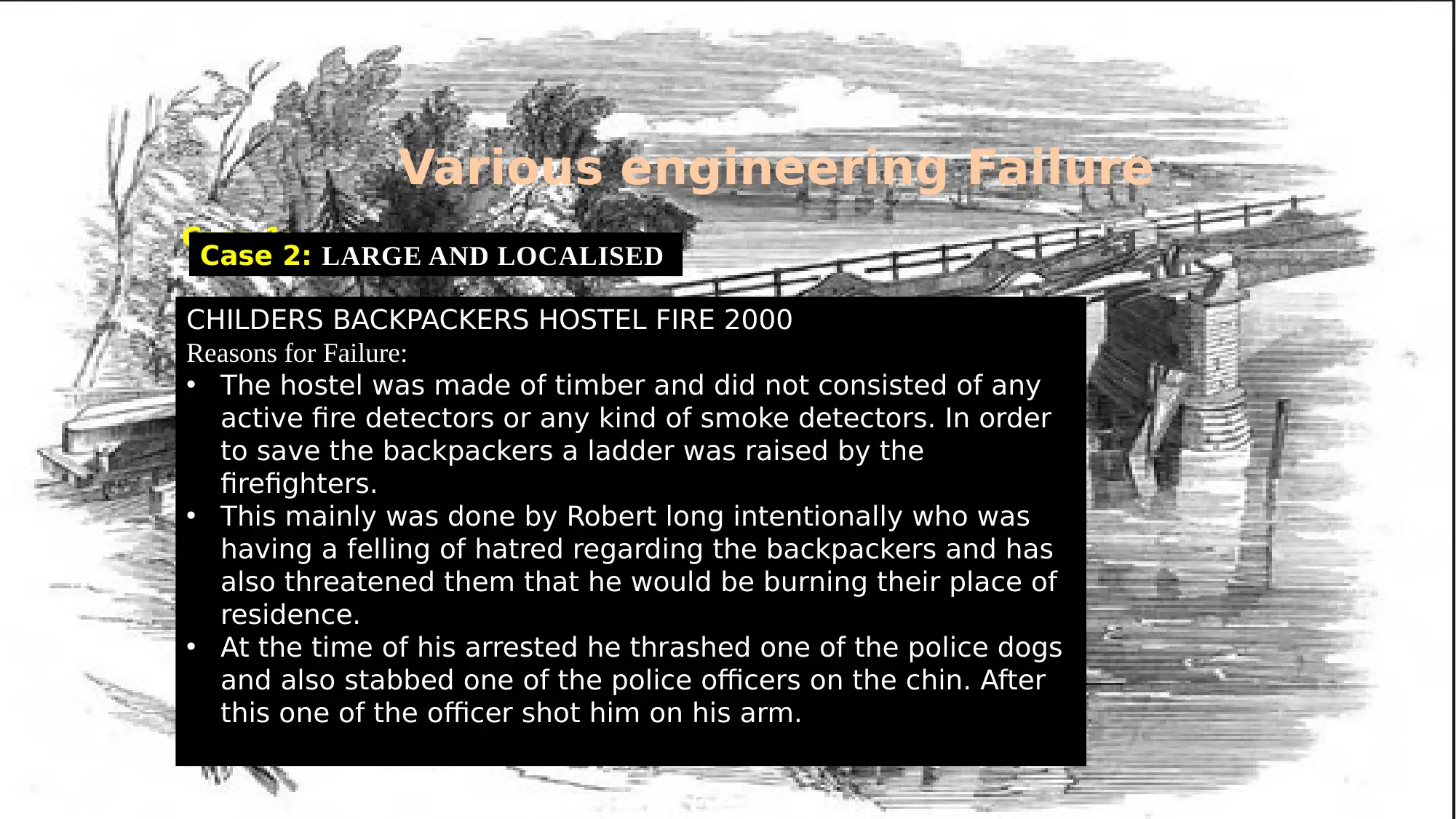
Various engineering Failure
Case 1: LARGE AND LOCALISED
CHILDERS BACKPACKERS HOSTEL FIRE 2000
Reasons for Failure:
• The hostel was made of timber and did not consisted of any
active fire detectors or any kind of smoke detectors. In order
to save the backpackers a ladder was raised by the
firefighters.
• This mainly was done by Robert long intentionally who was
having a felling of hatred regarding the backpackers and has
also threatened them that he would be burning their place of
residence.
• At the time of his arrested he thrashed one of the police dogs
and also stabbed one of the police officers on the chin. After
this one of the officer shot him on his arm.
Case 2: LARGE AND LOCALISED
Case 1: LARGE AND LOCALISED
CHILDERS BACKPACKERS HOSTEL FIRE 2000
Reasons for Failure:
• The hostel was made of timber and did not consisted of any
active fire detectors or any kind of smoke detectors. In order
to save the backpackers a ladder was raised by the
firefighters.
• This mainly was done by Robert long intentionally who was
having a felling of hatred regarding the backpackers and has
also threatened them that he would be burning their place of
residence.
• At the time of his arrested he thrashed one of the police dogs
and also stabbed one of the police officers on the chin. After
this one of the officer shot him on his arm.
Case 2: LARGE AND LOCALISED
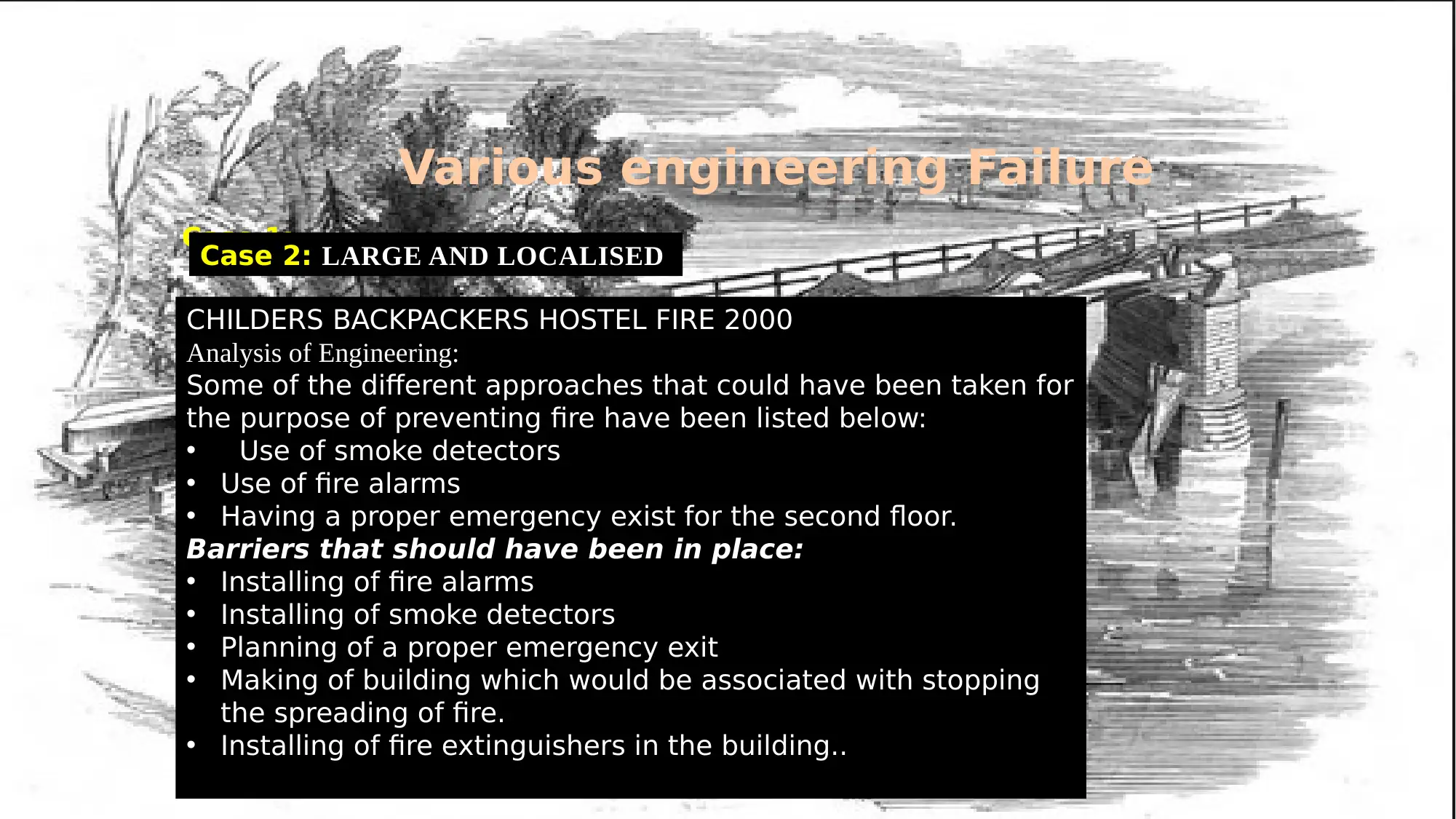
Various engineering Failure
Case 1: LARGE AND LOCALISED
CHILDERS BACKPACKERS HOSTEL FIRE 2000
Analysis of Engineering:
Some of the different approaches that could have been taken for
the purpose of preventing fire have been listed below:
• Use of smoke detectors
• Use of fire alarms
• Having a proper emergency exist for the second floor.
Barriers that should have been in place:
• Installing of fire alarms
• Installing of smoke detectors
• Planning of a proper emergency exit
• Making of building which would be associated with stopping
the spreading of fire.
• Installing of fire extinguishers in the building..
Case 2: LARGE AND LOCALISED
Case 1: LARGE AND LOCALISED
CHILDERS BACKPACKERS HOSTEL FIRE 2000
Analysis of Engineering:
Some of the different approaches that could have been taken for
the purpose of preventing fire have been listed below:
• Use of smoke detectors
• Use of fire alarms
• Having a proper emergency exist for the second floor.
Barriers that should have been in place:
• Installing of fire alarms
• Installing of smoke detectors
• Planning of a proper emergency exit
• Making of building which would be associated with stopping
the spreading of fire.
• Installing of fire extinguishers in the building..
Case 2: LARGE AND LOCALISED
⊘ This is a preview!⊘
Do you want full access?
Subscribe today to unlock all pages.

Trusted by 1+ million students worldwide
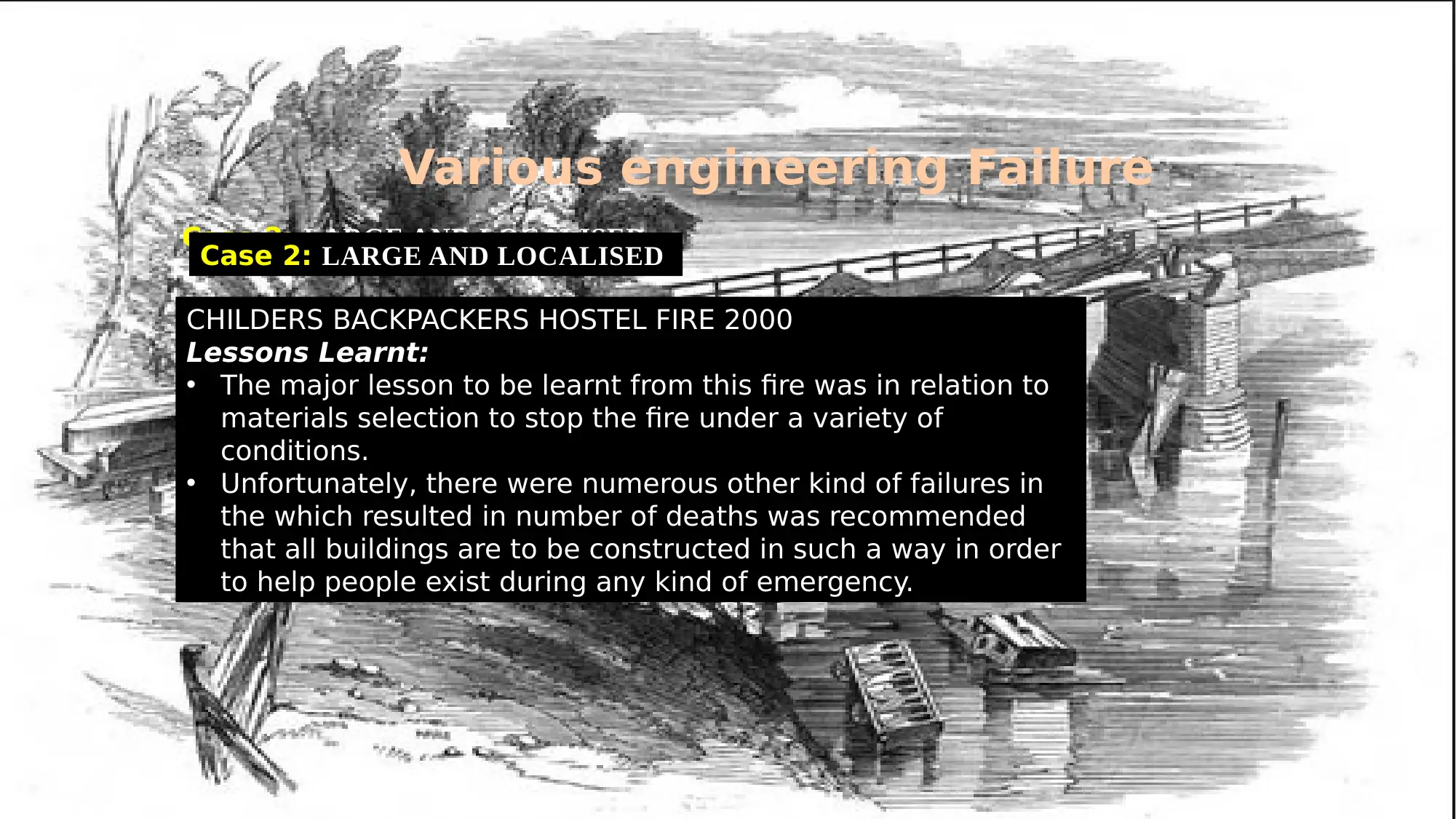
Various engineering Failure
Case 2: LARGE AND LOCALISED
CHILDERS BACKPACKERS HOSTEL FIRE 2000
Lessons Learnt:
• The major lesson to be learnt from this fire was in relation to
materials selection to stop the fire under a variety of
conditions.
• Unfortunately, there were numerous other kind of failures in
the which resulted in number of deaths was recommended
that all buildings are to be constructed in such a way in order
to help people exist during any kind of emergency.
Case 2: LARGE AND LOCALISED
Case 2: LARGE AND LOCALISED
CHILDERS BACKPACKERS HOSTEL FIRE 2000
Lessons Learnt:
• The major lesson to be learnt from this fire was in relation to
materials selection to stop the fire under a variety of
conditions.
• Unfortunately, there were numerous other kind of failures in
the which resulted in number of deaths was recommended
that all buildings are to be constructed in such a way in order
to help people exist during any kind of emergency.
Case 2: LARGE AND LOCALISED
Paraphrase This Document
Need a fresh take? Get an instant paraphrase of this document with our AI Paraphraser
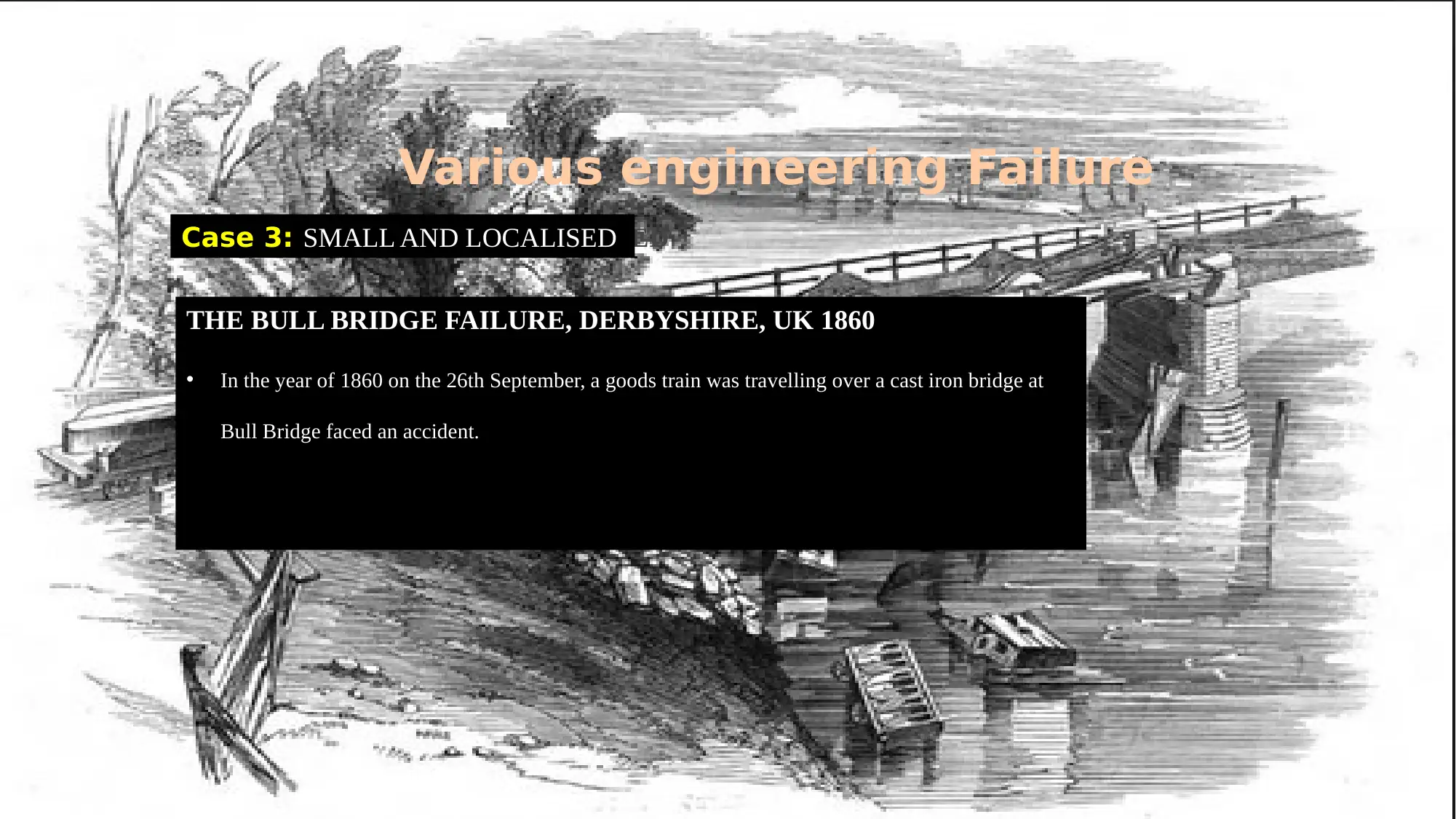
Various engineering Failure
Case 2: MEDIUM AND LOCALISED
THE BULL BRIDGE FAILURE, DERBYSHIRE, UK 1860
• In the year of 1860 on the 26th September, a goods train was travelling over a cast iron bridge at
Bull Bridge faced an accident.
Case 3: SMALL AND LOCALISED
Case 2: MEDIUM AND LOCALISED
THE BULL BRIDGE FAILURE, DERBYSHIRE, UK 1860
• In the year of 1860 on the 26th September, a goods train was travelling over a cast iron bridge at
Bull Bridge faced an accident.
Case 3: SMALL AND LOCALISED
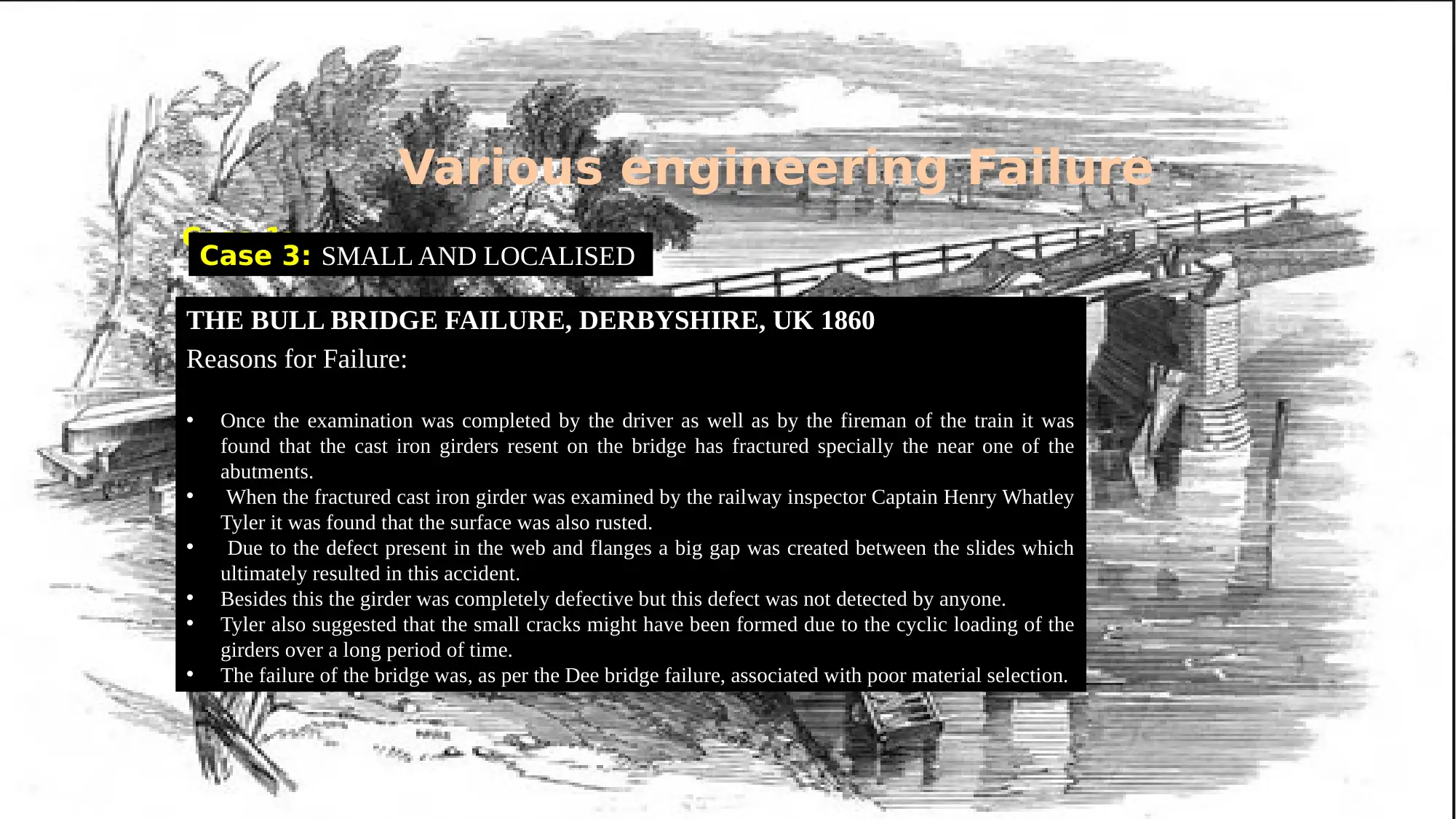
Various engineering Failure
Case 1: LARGE AND LOCALISED
THE BULL BRIDGE FAILURE, DERBYSHIRE, UK 1860
Reasons for Failure:
• Once the examination was completed by the driver as well as by the fireman of the train it was
found that the cast iron girders resent on the bridge has fractured specially the near one of the
abutments.
• When the fractured cast iron girder was examined by the railway inspector Captain Henry Whatley
Tyler it was found that the surface was also rusted.
• Due to the defect present in the web and flanges a big gap was created between the slides which
ultimately resulted in this accident.
• Besides this the girder was completely defective but this defect was not detected by anyone.
• Tyler also suggested that the small cracks might have been formed due to the cyclic loading of the
girders over a long period of time.
• The failure of the bridge was, as per the Dee bridge failure, associated with poor material selection.
Case 3: SMALL AND LOCALISED
Case 1: LARGE AND LOCALISED
THE BULL BRIDGE FAILURE, DERBYSHIRE, UK 1860
Reasons for Failure:
• Once the examination was completed by the driver as well as by the fireman of the train it was
found that the cast iron girders resent on the bridge has fractured specially the near one of the
abutments.
• When the fractured cast iron girder was examined by the railway inspector Captain Henry Whatley
Tyler it was found that the surface was also rusted.
• Due to the defect present in the web and flanges a big gap was created between the slides which
ultimately resulted in this accident.
• Besides this the girder was completely defective but this defect was not detected by anyone.
• Tyler also suggested that the small cracks might have been formed due to the cyclic loading of the
girders over a long period of time.
• The failure of the bridge was, as per the Dee bridge failure, associated with poor material selection.
Case 3: SMALL AND LOCALISED
⊘ This is a preview!⊘
Do you want full access?
Subscribe today to unlock all pages.

Trusted by 1+ million students worldwide
1 out of 14
Related Documents
Your All-in-One AI-Powered Toolkit for Academic Success.
+13062052269
info@desklib.com
Available 24*7 on WhatsApp / Email
![[object Object]](/_next/static/media/star-bottom.7253800d.svg)
Unlock your academic potential
Copyright © 2020–2025 A2Z Services. All Rights Reserved. Developed and managed by ZUCOL.





